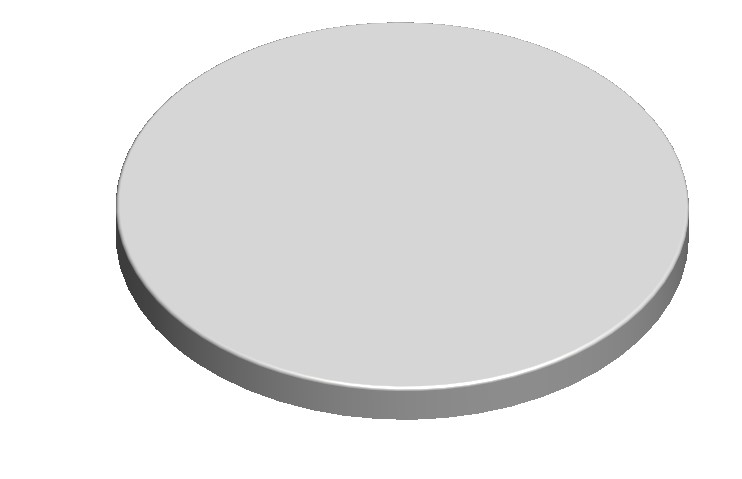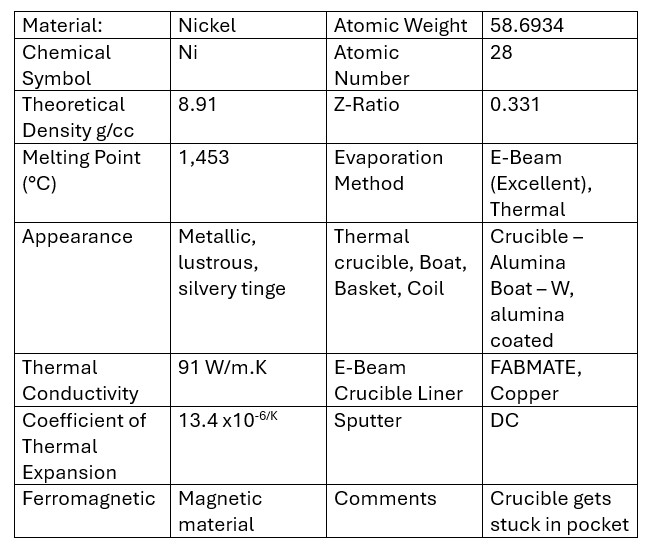Ideal Vacuum Circular Magnetron Sputtering Targets, NICKEL - Ni Sputtering Target, 3'' Diameter x 0.02" Thick, 99.99 Percent Purity
Delivery
Payment options
Our advantages
- — 12 months warranty
- — SMS notification
- — Return and exchange
- — Different payment methods
- — Best price
Ideal Vacuum Products, LLC.
This product is a circular magnetron NICKEL - Ni sputtering target, with a 3'' diameter x 0.02" thickness. It is 99.99% pure.
We use a very competitive pricing strategy to ensure you receive the highest quality products at the best possible value, giving you both affordability and excellence in every purchase. We offer huge discounts to every customer, customers who place bulk orders will enjoy huge savings. We stock huge quantities of our products to give our customers guaranteed same day shipping after placing an order. This short lead time is loved by all our customers who look to manage their cash flow with quicker turnaround times. Our regular customers can maintain lower inventory levels, decreasing storage costs and minimizing the risk of obsolescence. Buying from Ideal Vacuum means a customer receives their product more quickly, enhancing satisfaction and meeting their urgent needs. This also enables our customers to stay ahead of their competition by quickly adapting to new trends and demands.
NICKEL - Ni
Nickel (Ni) sputtering targets are commonly used for thin-film deposition in various industrial and technological applications due to nickel’s mechanical, magnetic, and chemical properties. Here's a concise summary of nickel sputtering targets in thin films:
1. Material Properties:
Magnetic Properties: Nickel is a ferromagnetic material, which makes it useful in magnetic thin-film applications such as data storage and sensors.
Electrical Conductivity: Nickel is a good conductor, making it suitable for electrical and microelectronic applications.
Corrosion Resistance: Nickel has excellent corrosion resistance, especially in mildly corrosive environments, making it ideal for protective coatings.
2. Deposition Methods:
DC Sputtering: Nickel, being a conductive material, is usually sputtered using DC magnetron sputtering, which allows for efficient deposition and higher sputtering rates.
RF Sputtering: Though less common for nickel, RF sputtering can be used when required in specialized applications.
Reactive Sputtering: Nickel can be sputtered in reactive environments to form nickel oxide (NiO) or other compounds for specific uses.
3. Applications:
Microelectronics: Nickel is used in thin-film resistors, interconnects, and contacts in semiconductor devices due to its electrical conductivity and thermal stability.
Magnetic Storage Devices: Nickel is a key material in magnetic thin films for use in hard drives, magnetic sensors, and spintronic devices.
Protective Coatings: Nickel thin films are often applied as corrosion-resistant coatings in industrial and chemical processing environments.
Catalysts: Nickel thin films are used as catalysts in certain chemical reactions, especially in hydrogen production and fuel cells.
4. Film Properties:
Mechanical Strength: Nickel thin films exhibit high strength and good adhesion to various substrates, making them suitable for protective coatings.
Magnetic Properties: Nickel thin films retain their magnetic properties, making them ideal for magnetic devices and sensors.
Corrosion Resistance: Nickel films provide effective protection against corrosion and oxidation in various environments.
Electrical Conductivity: Nickel thin films have good conductivity, making them valuable in electronics and electrical contacts.
5. Reactive Deposition:
Nickel Oxide (NiO): Nickel targets can be sputtered in an oxygen-rich environment to form nickel oxide films, which have applications in electrochromic devices, batteries, and gas sensors.
6. Challenges:
Magnetic Interference: Since nickel is a ferromagnetic material, special considerations are needed in sputtering systems to avoid interference with the magnetic field of the sputtering equipment, especially in magnetron sputtering.
Stress in Thin Films: Nickel films may develop internal stress during deposition, which can impact the film’s adhesion and mechanical properties.
Summary:
Nickel (Ni) sputtering targets are widely used for the deposition of thin films in microelectronics, magnetic devices, and protective coatings due to nickel’s magnetic, conductive, and corrosion-resistant properties. Nickel thin films are commonly applied using DC sputtering, and they find use in electronic components, magnetic storage media, protective layers, and catalysis. Nickel oxide (NiO) films can also be created through reactive sputtering for specific functional applications.
We use a very competitive pricing strategy to ensure you receive the highest quality products at the best possible value, giving you both affordability and excellence in every purchase. We offer huge discounts to every customer, customers who place bulk orders will enjoy huge savings. We stock huge quantities of our products to give our customers guaranteed same day shipping after placing an order. This short lead time is loved by all our customers who look to manage their cash flow with quicker turnaround times. Our regular customers can maintain lower inventory levels, decreasing storage costs and minimizing the risk of obsolescence. Buying from Ideal Vacuum means a customer receives their product more quickly, enhancing satisfaction and meeting their urgent needs. This also enables our customers to stay ahead of their competition by quickly adapting to new trends and demands.
NICKEL - Ni
Nickel (Ni) sputtering targets are commonly used for thin-film deposition in various industrial and technological applications due to nickel’s mechanical, magnetic, and chemical properties. Here's a concise summary of nickel sputtering targets in thin films:
1. Material Properties:
Magnetic Properties: Nickel is a ferromagnetic material, which makes it useful in magnetic thin-film applications such as data storage and sensors.
Electrical Conductivity: Nickel is a good conductor, making it suitable for electrical and microelectronic applications.
Corrosion Resistance: Nickel has excellent corrosion resistance, especially in mildly corrosive environments, making it ideal for protective coatings.
2. Deposition Methods:
DC Sputtering: Nickel, being a conductive material, is usually sputtered using DC magnetron sputtering, which allows for efficient deposition and higher sputtering rates.
RF Sputtering: Though less common for nickel, RF sputtering can be used when required in specialized applications.
Reactive Sputtering: Nickel can be sputtered in reactive environments to form nickel oxide (NiO) or other compounds for specific uses.
3. Applications:
Microelectronics: Nickel is used in thin-film resistors, interconnects, and contacts in semiconductor devices due to its electrical conductivity and thermal stability.
Magnetic Storage Devices: Nickel is a key material in magnetic thin films for use in hard drives, magnetic sensors, and spintronic devices.
Protective Coatings: Nickel thin films are often applied as corrosion-resistant coatings in industrial and chemical processing environments.
Catalysts: Nickel thin films are used as catalysts in certain chemical reactions, especially in hydrogen production and fuel cells.
4. Film Properties:
Mechanical Strength: Nickel thin films exhibit high strength and good adhesion to various substrates, making them suitable for protective coatings.
Magnetic Properties: Nickel thin films retain their magnetic properties, making them ideal for magnetic devices and sensors.
Corrosion Resistance: Nickel films provide effective protection against corrosion and oxidation in various environments.
Electrical Conductivity: Nickel thin films have good conductivity, making them valuable in electronics and electrical contacts.
5. Reactive Deposition:
Nickel Oxide (NiO): Nickel targets can be sputtered in an oxygen-rich environment to form nickel oxide films, which have applications in electrochromic devices, batteries, and gas sensors.
6. Challenges:
Magnetic Interference: Since nickel is a ferromagnetic material, special considerations are needed in sputtering systems to avoid interference with the magnetic field of the sputtering equipment, especially in magnetron sputtering.
Stress in Thin Films: Nickel films may develop internal stress during deposition, which can impact the film’s adhesion and mechanical properties.
Summary:
Nickel (Ni) sputtering targets are widely used for the deposition of thin films in microelectronics, magnetic devices, and protective coatings due to nickel’s magnetic, conductive, and corrosion-resistant properties. Nickel thin films are commonly applied using DC sputtering, and they find use in electronic components, magnetic storage media, protective layers, and catalysis. Nickel oxide (NiO) films can also be created through reactive sputtering for specific functional applications.


Notes:
Metallic or elastomer backing plate bonding is recommended for all dielectric target materials because these materials have characteristics which are not amenable to sputtering, such as, brittleness and low thermal conductivity. These targets are most susceptible to thermal shock due to their low thermal conductivity and hence, may require specific power ramp up and ramp down procedures during start up and shut down steps.
Please sign in so that we can notify you about a reply











